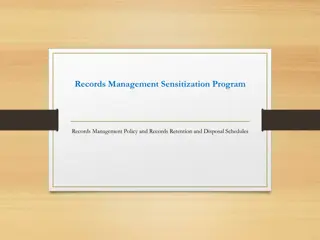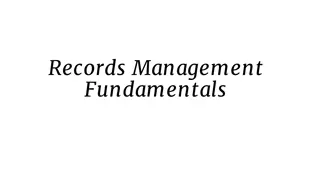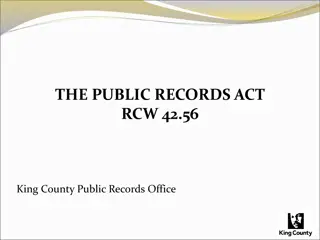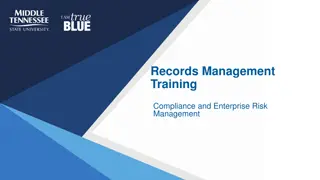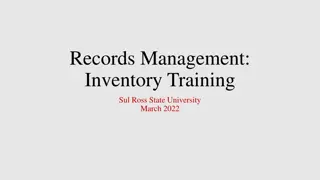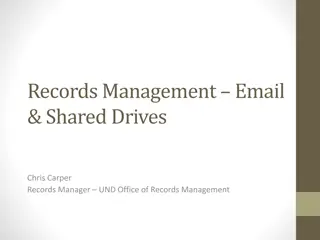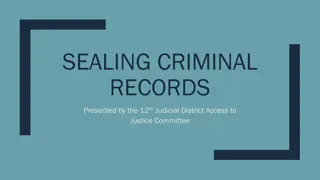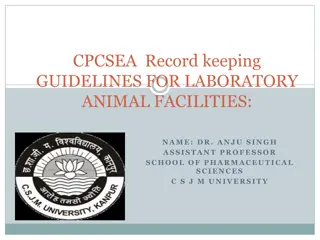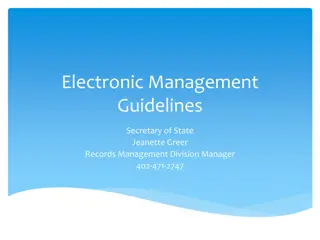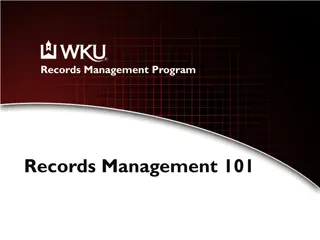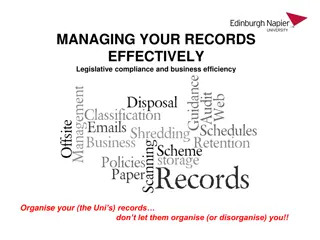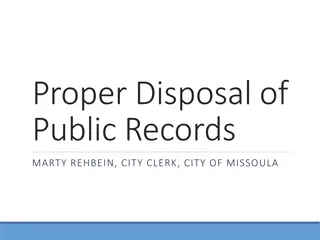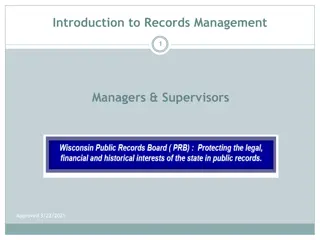Government Records Management Guidelines
Public authorities are required to maintain and index records for easy access under the law, ensuring computerization and network connectivity to ease record retrieval. The guidelines detail categorization of physical and digital records for preservation and reference, with specific periods for retention based on importance.
Download Presentation

Please find below an Image/Link to download the presentation.
The content on the website is provided AS IS for your information and personal use only. It may not be sold, licensed, or shared on other websites without obtaining consent from the author. Download presentation by click this link. If you encounter any issues during the download, it is possible that the publisher has removed the file from their server.
E N D
Presentation Transcript
Section 4(1) Every public authority shall- a) maintain all its records duly catalogued and indexed in a manner and the form which facilitates the right to information under this Act and ensure that all records that are appropriate to be computerised are, within a reasonable time and subject resources, computerised and connected through a network all over the country on different systems so that access to such records is facilitated; to availability of
DARPG procedure, e-office procedure and Record Retention Schedule for common Ministries/Department. is the nodal Department for- office records to all Latest instructions- office procedure - 14thEdition of CSMOP based work published in 2012 -1st e-office edition of CSMeOP, Record Retention Schedule,2012 (All these guidelines are hosted on the website of DARPG)
Physical Records are divided into three categories Category A meaning keep and microfilm - (a) Files for permanent preservation because they contain: i. a document so precious that its original must be preserved intact and access to it in the original form must be restricted to the barest minimum to avoid its damage or loss; or ii. material likely to be required for frequent reference by different parties simultaneously/frequently. (b) Files of historical importance 1.
2. Category B meaning keep but do not microfilm- permanent preservation for administrative purpose. 3. Category C meaning keep for specified period only . files of secondary importance with reference value not exceeding 10 years. if the record is required to be retained beyond 10 years it will be upgraded to B Category. (C-1, C-3, C-5 & C-10 - Category C file to be kept for1 year, 3 years, 5 years and 10 years )
Category I e-files which qualify for permanent preservation for administrative purposes or due to historical importance. Category II e- files of secondary importance with reference value not exceeding 20 years. In exceptional cases if the records are required to be retained beyond 20 years it will be upgraded to category I. Backup of Digital records- Two copies to be maintained-at Data Centre/Digital Record Room (responsibility of NIC/NAI/any other agency designated by the Government) and at Disaster Recovery Site.
Records management - recording, retention, retrieval and disposal by transfer to National Achieves of India (NAI). Public Records Act, 1993 and the Public Records Rules, 1998 provide for a Departmental Records Officer (DRO) Files are recorded after action is complete. Retained as per the provisions in the Record Retention Schedule and that of of NAI issued from time to time. Each Department is expected to issue instructions to regulate and review of records
To ensure that files etc are neither prematurely destroyed nor kept for the periods longer then necessary a) in respect of records connected with accounts observe instructions contained in GFR b) in respect of records relating to establishment , personnel and housekeeping matters common to all departments, follow the Record Retention Schedule prescribed by DARPG c) in respect of records connected with substantive functions, issue departmental retention schedule
Record relates to two or more subjects -will be retained for the highest of such periods. In exceptional cases, i.e. record with certain special features -may be retained for longer period than prescribed in RRS No record to be retained for a period shorter than that prescribed in the schedule. Record required for disposal of another record- not to be weeded out until all issues finally decided. Retention periods initially marked on such records to be consciously reviewed and, where necessary, revised suitably.
Custody of Records- In the event of transfer of work from one section to another or department or National Archive of India (NAI) the relevant files will be transferred Printed publications, spare copies of circulars, orders, etc, to be periodically reviewed for weeding out. (procedure laid down in CSMOP) Records maintained by officers and their personal staff- Department may issue Departmental instructions to regulate the review and weeding out/deleting of paper records maintained by officers and their personal staff. Requisitioning of records- requisition in form prescribed under Public records Act, 1993 (Ministry of Culture)
The guidelines have sufficient provisions which if followed diligently will result in better record keeping and easy retrieval and help Public authorities in discharge of their functions under RTI Act.












